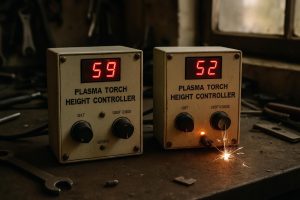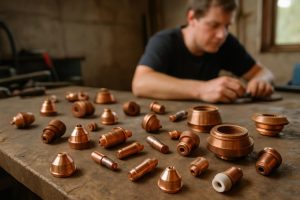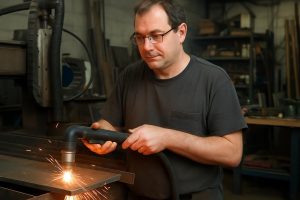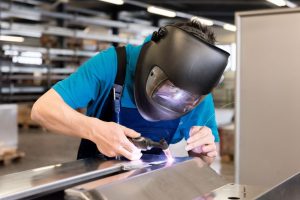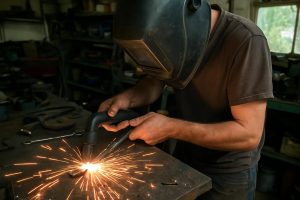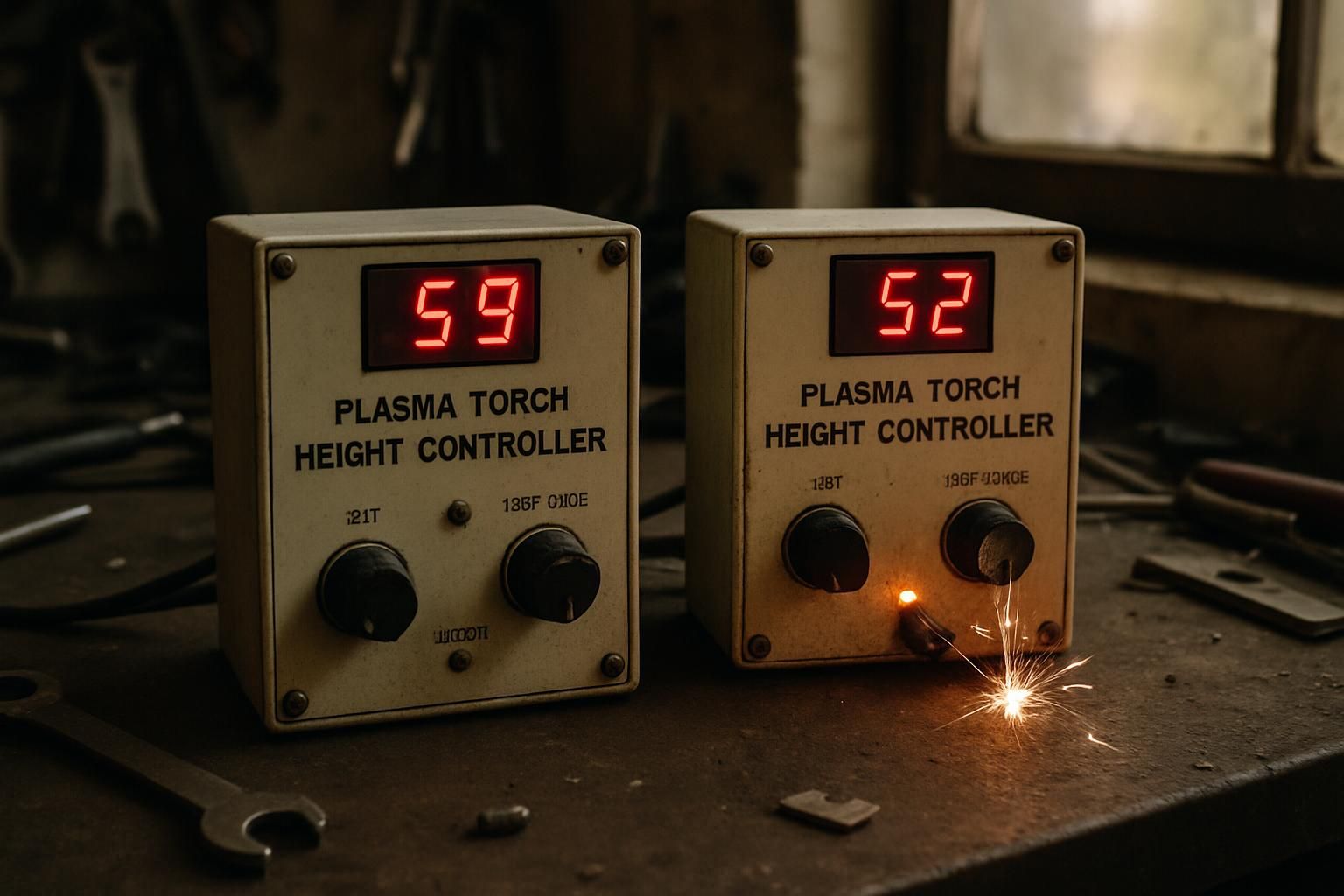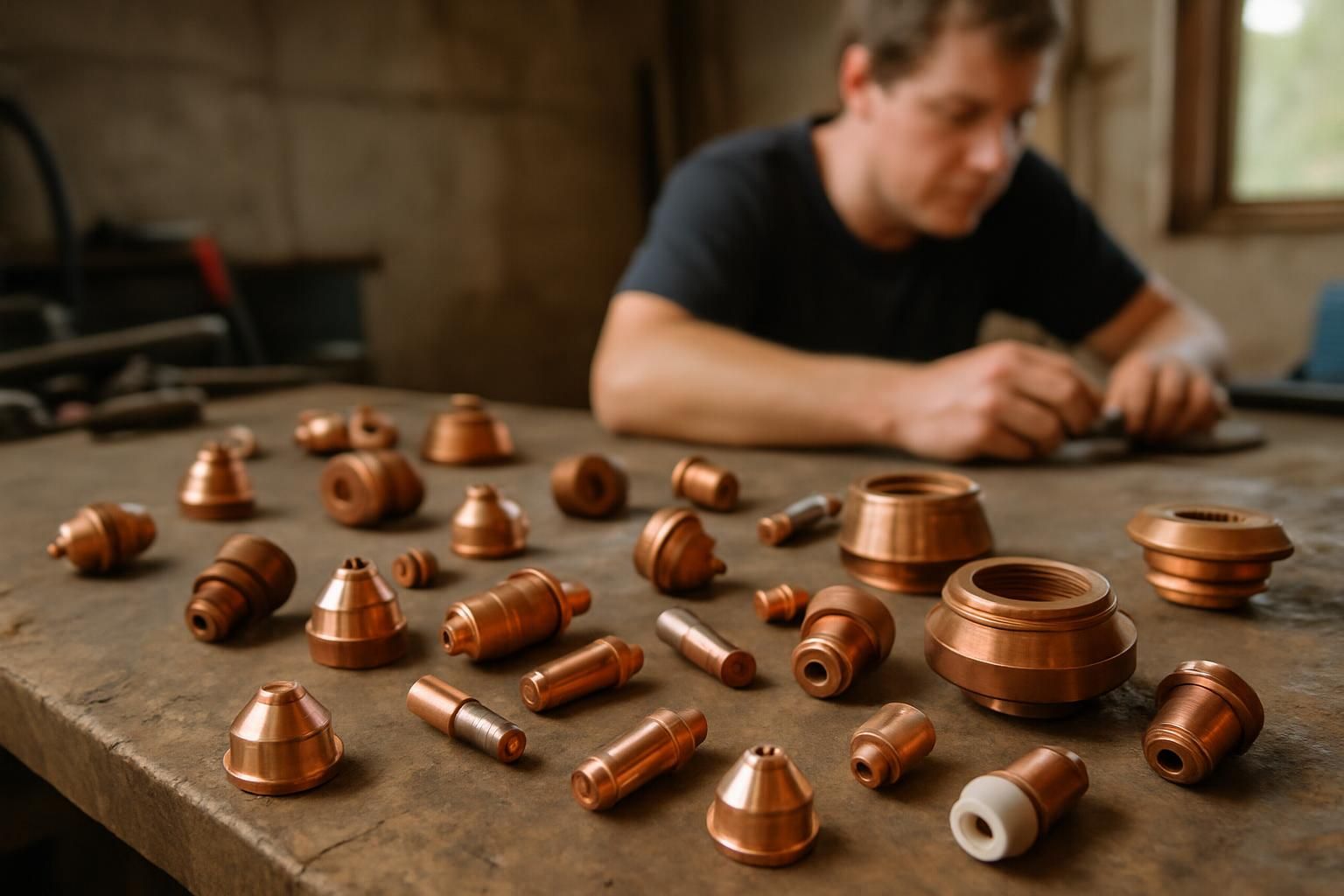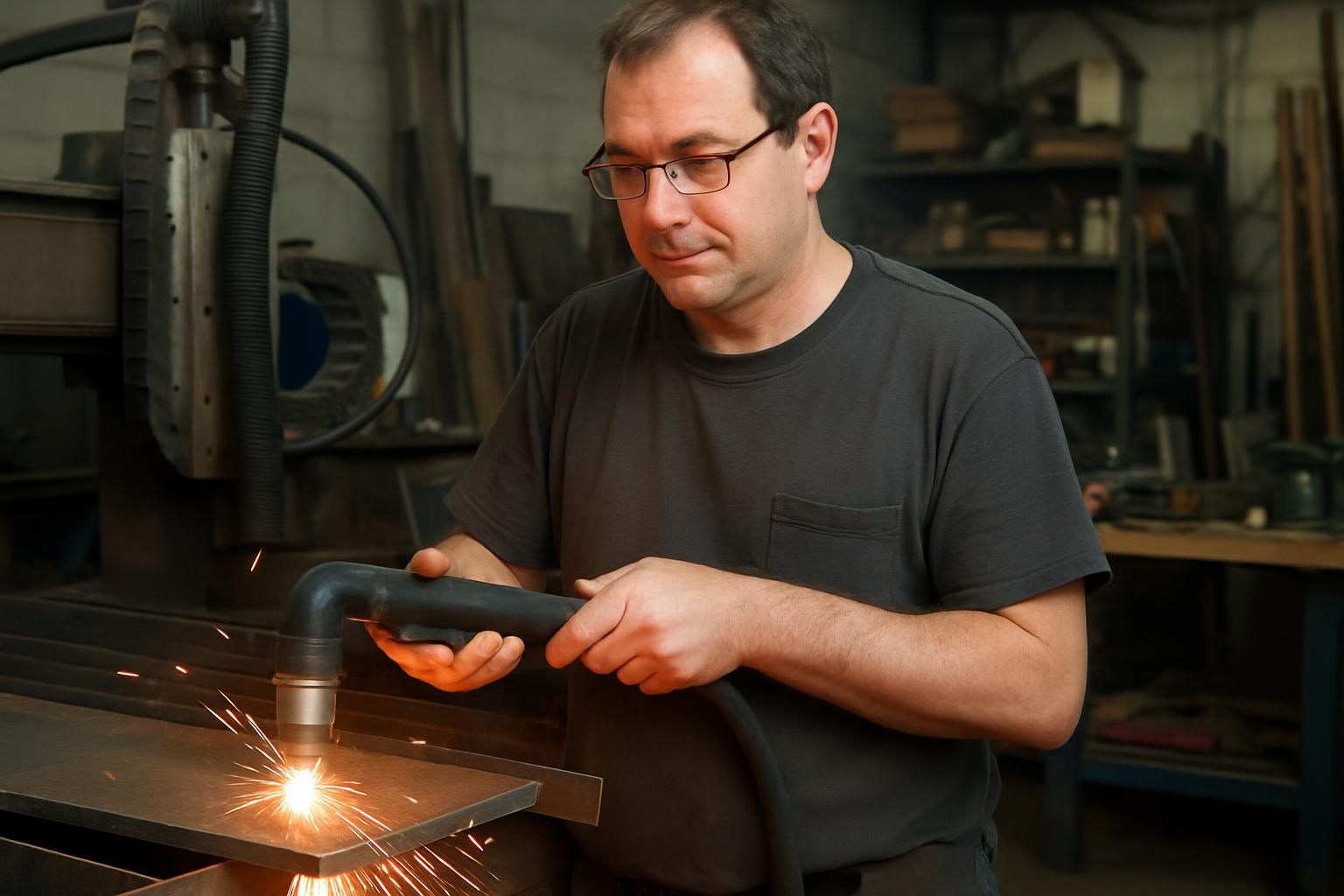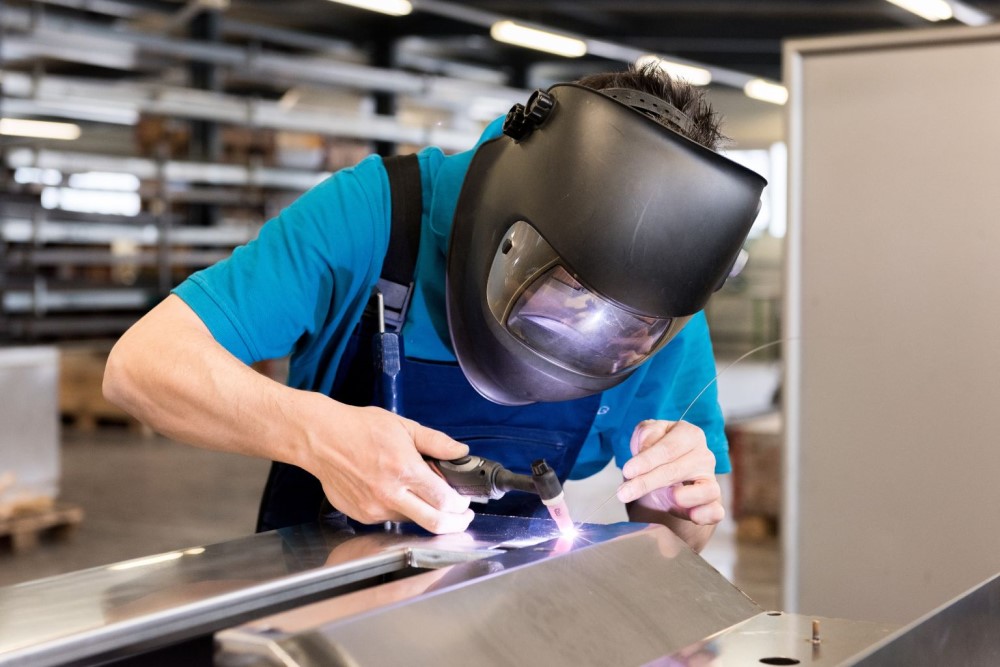Plasma cutters are powerful tools for slicing through metal, but their performance hinges on one crucial component – the electrode. We’ve seen many users struggle with electrode issues, so let’s dive into what affects electrode life and how to get the most out of these essential parts.

The typical lifespan of a plasma cutter electrode is about 1-2 saat of continuous cutting time before it needs replacement. This can vary based on factors like cutting amperage, material thickness, and proper maintenance. The electrode develops a pit as it’s used, and once this pit reaches about 1/16 inch deep, it’s time for a new one.
We’ve found that proper care can greatly extend electrode life. This includes using the right air pressure, avoiding excessive starts and stops, and keeping the torch clean. For Hypertherm Powermax users, we’ve seen even longer electrode life when using their proprietary consumables and following manufacturer guidelines.
Temel Çıkarımlar
- Plasma cutter electrodes typically last 1-2 hours of continuous cutting before needing replacement
- Electrode pits deeper than 1/16 inch indicate it’s time for a change
- Proper maintenance and following manufacturer guidelines can significantly extend electrode life
Understanding Electrode Fundamentals

Plasma cutter electrodes play a crucial role in the cutting process. Let’s explore the key aspects of these essential components.
Types of Electrode Materials
Electrodes come in different materials, each with unique properties. The most common type uses hafnium as the emitting element. Hafnium can handle extreme heat, making it ideal for plasma cutting.
Some electrodes use other materials like tungsten or zirconium. These work well for specific applications. The choice depends on the cutting gas and amperage used.
We’ve found that hafnium electrodes last longer when cutting with oxygen. For other gases, different materials might be better. It’s important to match the electrode to your specific needs.
Basic Working Mechanism
The electrode is where the magic happens in plasma cutting. It’s the starting point of the plazma ark. Here’s how it works:
- The electrode gets a negative charge.
- Gas flows around it.
- An electric current jumps from the electrode to the workpiece.
- This creates a super-hot plasma arc.
The tip of the electrode can reach over 3000°F! That’s why proper cooling is so important. The plasma arc melts the metal, and the high-speed gas blows it away.
Key Components and Their Interactions
Several parts work together with the electrode:
- Swirl ring: Helps the gas flow in a spiral
- Nozzle: Focuses the plasma arc
- Shield cap: Protects the nozzle and improves cut quality
- Retaining cap: Holds everything in place
These torch components all affect how well the electrode works. For example, a worn nozzle can make the electrode wear out faster.
We always check all parts before cutting. This helps prevent damage and ensures good cuts. Remember, a bad electrode can harm other torch parts too.
Factors Affecting Electrode Lifespan

Several key factors impact how long plasma cutter electrodes last. These include the cutting settings, techniques used, gas quality, usage frequency, and environmental conditions. Let’s explore each of these in more detail.
Amperage And Cutting Current
The amount of current used during plasma cutting directly affects electrode life. Higher amperages cause more wear on the electrode tip. We’ve found that:
- Lower currents (30-50 amps) are gentler on electrodes
- Medium currents (60-80 amps) provide a good balance
- High currents (90+ amps) significantly reduce lifespan
It’s best to use the lowest amperage that still provides good Kalite Kesmek for your material. This helps maximize electrode life without sacrificing performance.
Cutting Techniques
How you operate the plasma cutter impacts consumable life. Good techniques include:
- Starting cuts from the edge when possible
- Minimizing pierces, which cause extra wear
- Maintaining proper standoff distance
- Using the right travel speed
Düzgün Kesme Teknikleri reduce unnecessary stress on electrodes. We recommend practicing to develop smooth, consistent movements.
Gas Quality And Purity
Clean, dry gases are crucial for electrode longevity. Contaminants in the gas can quickly degrade consumables. Key points:
- Use gases specifically made for plasma cutting
- Install and maintain gas filtration systems
- Check for moisture or oil in air compressor lines
- Consider using nitrogen instead of shop air
High-purity gases help electrodes last 2-3 times longer in many cases.
Frequency Of Use
How often you use your plasma cutter affects electrode wear. Frequent starts and stops cause more degradation than long, continuous cuts. We’ve observed:
- Daily use requires more frequent replacements
- Weekly use allows longer intervals between changes
- Occasional use may let electrodes last for months
It’s important to inspect electrodes regularly, even with infrequent use. Old consumables can damage other torch parts.
Çevre koşulları
The environment around your plasma cutter plays a role in electrode life. Factors to consider:
- Temperature – extreme heat or cold affects performance
- Humidity – moisture in the air can contaminate gases
- Dust and debris – airborne particles cause wear
- Proper ventilation – removes fumes and heat
We recommend using your plasma cutter in a clean, temperature-controlled area when possible. This helps protect both the equipment and consumables.
Electrode Performance Metrics

Plasma cutter electrode performance is crucial for achieving optimal cutting results. We’ll explore key metrics to evaluate electrode effectiveness and longevity.
Average Lifespan Expectations
Plasma cutter electrodes typically last 1-2 hours of arc-on time or 200-300 pierces before needing replacement. This can vary based on factors like cutting intensity and material thickness.
Proper care and usage can extend electrode life. We’ve found that using the right gas flow rates and avoiding overuse can add 20-30% to an electrode’s lifespan.
It’s important to note that cheaper electrodes often have shorter lifespans. Premium brands may cost more upfront but can offer 5-10 times longer life, saving money in the long run.
Performance Benchmarks
Key performance benchmarks for plazma kesici electrodes include:
- Cut quality: Clean, smooth edges with minimal dross
- Cut speed: Faster cutting without sacrificing quality
- Piercing capability: Number of successful pierces before failure
- Consistency: Maintaining performance over the electrode’s life
We’ve created a simple table to compare typical benchmarks:
| Metrik | Entry-level | Mid-range | High-end |
|---|---|---|---|
| Kalite Kesmek | Fair | İyi | Harika |
| Cut speed | Yavaş | Ilıman | Hızlı |
| Pierces | 100-200 | 200-300 | 300+ |
| Consistency | Değişken | Stable | Very stable |
Measuring Electrode Wear
Monitoring electrode wear is essential for maintaining cut quality. Signs of wear include:
- Deep pitting on the electrode tip
- Uneven erosion of the hafnium insert
- Discoloration or warping of the copper body
We recommend using a simple magnifying glass to inspect electrodes regularly. Measure the depth of the pit with a depth gauge. Replace electrodes when the pit depth reaches 1mm or if you notice any unusual wear patterns.
Tracking arc-on time and pierce count can also help predict when replacement is needed. Some modern plasma cutters have built-in monitoring systems that alert users when electrodes need changing.
Comparative Analysis Of Different Electrode Types
Plasma cutter electrodes come in various types, each with unique performance characteristics:
- Standard copper electrodes:
- Good for mild steel cutting
- Moderate lifespan
- Lower cost
- Silver-tipped electrodes:
- Better heat dissipation
- Longer lifespan than standard copper
- Higher initial cost, but often more cost-effective long-term
- Hafnium-insert electrodes:
- Excellent for high-amperage cutting
- Longest lifespan
- Best performance on thick materials
We’ve found that matching the electrode type to your specific cutting needs can significantly improve performance and reduce overall costs. For example, using silver-tipped electrodes for frequent, high-volume cutting can result in 30-40% longer life compared to standard copper electrodes.
Maintenance And Care Strategies

Taking good care of your plasma cutter electrodes is key to getting the most out of them. We’ll share some handy tips to keep your electrodes in top shape and extend their life.
Proper Handling Techniques
When handling plasma cutter electrodes, always use clean gloves. This stops oils and dirt from your hands getting on them. Never touch the tip with bare fingers – it’s very sensitive!
Be gentle when putting electrodes in or taking them out. Don’t force them or bang them around. A light touch is best.
Make sure the electrode is seated properly in the torch. A loose fit can cause damage fast. Double-check it’s snug but not over-tightened.
Cleaning And Storage Recommendations
Clean your electrodes after each use. A soft cloth works well for wiping off dust and debris. For tougher grime, try a mild soap solution. Rinse with clean water and dry fully.
Store electrodes in a cool, dry place. Moisture is their enemy! A sealed container with silica gel packets helps keep humidity away.
Keep electrodes organized. Don’t let them roll around loose where they might get scratched. Foam inserts or divided boxes work great for this.
Preventive Maintenance Practices
Check coolant flow often. Low coolant can overheat electrodes fast. Top up fluids as needed and look for leaks.
Inspect electrical connections regularly. Loose or dirty contacts cause uneven wear. Clean and tighten them as part of your routine.
Replace consumables before they’re totally shot. Waiting too long leads to poor cuts and can damage your torch.
Set up a maintenance schedule and stick to it. Weekly checks catch small issues before they become big problems.
Signs Of Electrode Degradation
Watch for changes in cut quality. Ragged edges or difficulty starting the arc are red flags.
Look at the electrode tip. A cratered or pitted surface means it’s time for a new one.
Pay attention to how the machine runs. Increased voltage or unstable arc are signs of wear.
Keep track of usage hours. Most electrodes have a expected lifespan. Knowing when you’re due for a change helps avoid surprises.
Optimization Techniques

Extending electrode life in plasma cutters involves several key strategies. We’ll explore practical methods to maximize performance and reduce costs.
Best Practices For Extending Electrode Life
To get the most out of your plasma cutter electrodes, proper care is crucial. Clean your torch regularly to remove debris. This keeps the electrode cool and functioning well.
Always use the right consumables for your specific machine. Mixing brands or using knock-offs can lead to early failure.
When starting a cut, pierce at the correct height. Too low, and you’ll damage the electrode. Too high, and the arc may not transfer.
Avoid unnecessarily long pilot arcs. These wear out electrodes faster. Instead, start cutting as soon as the arc transfers to the workpiece.
Cutting Technique Modifications
Smart cutting techniques can greatly extend electrode life. When possible, start cuts from the edge of the material. This reduces wear from piercing.
For thicker materials, use a moving pierce. Slowly lower the torch while moving it slightly. This spreads out the heat and reduces electrode stress.
Optimize your lead-ins and lead-outs. A gradual ramp-up at the start and a controlled ramp-down at the end of a cut reduce electrode wear.
Try to minimize the number of starts and stops in your cutting path. Each start puts extra strain on the electrode.
Equipment Setting Adjustments
Proper machine settings are key to electrode longevity. Set your amperage correctly for the material thickness. Too high, and you’ll wear out parts faster.
Adjust gas pressure and flow rates to match your consumables and cutting task. Incorrect gas settings can cause rapid electrode wear.
Use the right cutting speed. Too slow, and excess heat builds up. Too fast, and the cut quality suffers. Both extremes wear out electrodes quicker.
For CNC systems, fine-tune your height control. Keeping the torch at the optimal distance from the workpiece reduces electrode stress.
Cost-Effective Maintenance Approaches
Regular maintenance saves money in the long run. Inspect your consumables daily. Replace them at the first signs of wear, not when they fail completely.
Keep spare parts on hand. This prevents rushed, potentially incorrect replacements when something fails.
Train operators properly. Well-trained staff make fewer mistakes that could damage electrodes.
Consider using higher-quality consumables. They may cost more upfront but often last longer, saving money over time.
Track consumable life and cutting performance. This data helps identify issues early and optimize your processes for better electrode life.
Troubleshooting Common Electrode Issues

Electrode problems can really mess up your plasma cutting. Let’s look at how to spot issues, fix them, and keep your cutter working great.
Identifying Wear Patterns
We need to check our electrodes often. Look for a pit in the center – that’s normal wear. But if it’s deep or uneven, that’s a problem.
Rough or melted edges mean the electrode is too hot. This can happen if we cut too fast or use the wrong amperage.
Discoloration or black marks? That could be from moisture or oil. We should clean our air supply and check for leaks.
Here’s a quick guide to wear patterns:
- Small, even pit: Normal wear
- Deep pit: Time to replace
- Rough edges: Adjust settings
- Black marks: Check air quality
Diagnosing Performance Problems
Bad electrodes can cause all sorts of issues. Are we getting a weak arc? The electrode might be worn out.
Is the cut quality poor? We might need to replace the electrode. Double arcing or difficulty starting the arc are also signs of electrode problems.
Let’s check these things:
- Arc stability
- Kalite Kesmek
- Starting issues
- Unusual noises
If we’re having any of these problems, it’s time to take a close look at our electrode.
Replacement Guidelines
How often should we change our electrode? It depends on how much we use our cutter. But here are some general rules:
- Every 3-4 hours of continuous cutting
- When the pit is deeper than 1/16 inch
- If we notice any performance issues
We should always change the nozzle and electrode together. They wear as a pair, and changing just one can lead to problems.
It’s a good idea to keep spare electrodes on hand. We don’t want to be caught without one when we’re in the middle of a big job!
Potential Performance Impacts
A worn electrode can really hurt our cutting performance. We might see:
- Crooked cuts
- Wider kerf
- More dross
- Daha yavaş kesme hızları
These issues can waste material and time. They can also be dangerous if our cuts aren’t accurate.
By replacing our electrode regularly, we can:
- Improve cut quality
- Extend the life of other parts
- Reduce overall operating costs
- Ensure safer operation
Remember, a little preventive maintenance goes a long way in plasma cutting. Let’s keep our electrodes in good shape for the best results!
Ekonomik Hususlar

Plasma cutter electrode life has a big impact on costs and efficiency. Let’s look at the key financial aspects to keep in mind.
Cost Of Electrode Replacement
Electrodes don’t last forever. We need to factor in regular replacement costs. A typical electrode may cost $20-$50, depending on quality and brand. High-end electrodes can run $100 or more.
How often do we need new ones? It depends on use, but every 1-3 months is common for busy shops. That adds up fast! A shop might spend $500-$1000 per year just on electrodes for one machine.
We can’t forget labor costs for changing them out. It only takes 5-10 minutes, but that’s still time away from cutting. Over a year, it can add up to several hours of downtime.
Long-Term Maintenance Strategies
Smart planning helps us save money long-term. Here are some tips:
• Buy in bulk for discounts • Use high-quality electrodes that last longer • Train staff on proper use and care • Clean and inspect electrodes regularly • Track usage to predict replacement needs
We can also look into refurbished electrodes. They cost less but may not last as long as new ones. It’s a trade-off to consider.
Impact On Overall Cutting Efficiency
Electrode life affects more than just replacement costs. As electrodes wear down, cut quality suffers. We might see:
• Slower cutting speeds • Rough edges needing more cleanup • More dross to remove • Increased material waste
These issues slow down work and increase labor costs. They can also lead to customer complaints if not caught in time.
ROI Of Proper Electrode Management
Good electrode care pays off. Let’s break down the benefits:
- Longer electrode life = fewer replacements
- Better cut quality = less rework
- Faster cutting = more jobs completed
- Less downtime = higher productivity
We estimate good practices can boost electrode life by 20-30%. That’s big savings! On a $50 electrode, we might save $10-$15 per use. Over a year, that could mean $200-$300 in savings per machine.
But the real value is in productivity gains. Even a 5% boost in cutting speed or quality can mean thousands more in revenue. It’s clear that taking care of our electrodes is just good business.
Advanced Topics And Emerging Technologies

New technologies are transforming plasma cutter electrode life. Let’s explore some exciting developments that are pushing the boundaries of what’s possible.
Innovative Electrode Materials
We’ve seen amazing progress in electrode materials. Hafnium inserts are a game-changer. They boost electrode lifespan and cut quality. Some new electrodes use hafnium mixed with other metals. This creates super-tough alloys.
Copper electrodes are getting better too. New copper alloys conduct heat and electricity really well. They resist wear and tear like champs. We’re even seeing electrodes made with exotic materials like graphene. These could be the future of plasma cutting.
What about coatings? Nano-coatings are thin but mighty. They protect electrodes from the harsh plasma environment. This means longer life and steadier performance.
Elektrot tasarımında gelecekteki eğilimler
Electrode design is evolving fast. We’re seeing some cool new shapes. Grooved electrodes help plasma flow better. This means cleaner cuts and less wear.
Multi-part electrodes are catching on. They let us replace just the worn bits. It’s cheaper and creates less waste. Some new designs use liquid cooling. This keeps electrodes cooler during long cuts.
Smart electrodes are on the horizon. They might have sensors to track wear. Imagine your plasma cutter telling you when to change the electrode!
Teknolojik Gelişmeler
AI is changing the game. Smart plasma systems adjust on the fly. They tweak power and gas flow to match the metal. This means better cuts and longer electrode life.
High-frequency start systems are getting better. They light the arc without touching the metal. This reduces electrode wear from starts and stops.
We’re also seeing progress in power supplies. New inverter tech delivers steadier power. This means a more stable arc and less electrode wear.
Potential Improvements in Electrode Longevity
We’re always looking for ways to make electrodes last longer. One big area is heat management. Better cooling systems keep electrodes from overheating.
New gas mixes are promising. They can protect the electrode while still cutting well. Some systems use different gases for different parts of the cut.
We’re also working on smarter consumable designs. Self-aligning parts ensure perfect fit every time. This cuts down on wear from misalignment.
Automated systems are helping too. They optimize cut paths and piercing techniques. This reduces unnecessary wear on the electrode.
Sık sorulan sorular

Plasma cutter electrodes are a key component that affects kesme performansı and efficiency. Let’s explore some common questions about their lifespan and maintenance.
How long does a plasma cutter electrode typically last?
Plasma cutter electrodes usually last between 1-2 hours of actual cutting time. This can vary based on factors like cutting frequency and material thickness. We’ve found that proper care and technique can help extend electrode life.
What factors influence the lifespan of a plasma cutter electrode?
Several things impact electrode life:
- Amper Kesme
- Malzeme kalınlığı
- Air pressure settings
- Kesme hızı
- Torch height
Using the right settings for each job makes a big difference. We always check our manual for the best parameters.
When is the right time to replace the electrode in a plasma cutting torch?
It’s time to swap out the electrode when:
- The pit in the tip is deeper than 1-1.6 mm
- Cut quality drops noticeably
- The arc becomes unstable
Catching these signs early helps avoid damage to other parts. We check our electrodes often during use.
Can plasma cutter electrodes from different brands be used interchangeably?
In most cases, no. Electrodes are designed for specific torch models. Using the wrong type can cause poor cuts or damage. We always stick to the manufacturer’s recommended parts for best results.
What are the signs of wear to look out for on a plasma cutter electrode?
Keep an eye out for:
- A deep pit in the center
- Discoloration or melting around the edges
- Uneven wear patterns
These signs mean it’s time for a new electrode. Regular checks help us catch wear early.
How does the nozzle size impact the life of a plasma cutter electrode?
Nozzle size plays a big role:
- Smaller nozzles focus the arc, which can wear electrodes faster
- Larger nozzles spread the heat, potentially extending electrode life
We match our nozzle size to the job at hand for the best balance of cut quality and electrode life.




